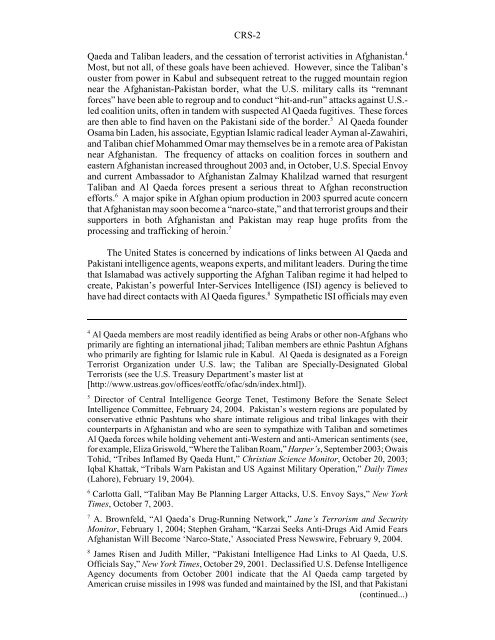Terrorism in South Asia - University of Maryland School of Law
Terrorism in South Asia - University of Maryland School of Law
Terrorism in South Asia - University of Maryland School of Law
You also want an ePaper? Increase the reach of your titles
YUMPU automatically turns print PDFs into web optimized ePapers that Google loves.
CRS-2<br />
Qaeda and Taliban leaders, and the cessation <strong>of</strong> terrorist activities <strong>in</strong> Afghanistan. 4<br />
Most, but not all, <strong>of</strong> these goals have been achieved. However, s<strong>in</strong>ce the Taliban’s<br />
ouster from power <strong>in</strong> Kabul and subsequent retreat to the rugged mounta<strong>in</strong> region<br />
near the Afghanistan-Pakistan border, what the U.S. military calls its “remnant<br />
forces” have been able to regroup and to conduct “hit-and-run” attacks aga<strong>in</strong>st U.S.-<br />
led coalition units, <strong>of</strong>ten <strong>in</strong> tandem with suspected Al Qaeda fugitives. These forces<br />
are then able to f<strong>in</strong>d haven on the Pakistani side <strong>of</strong> the border. 5 Al Qaeda founder<br />
Osama b<strong>in</strong> Laden, his associate, Egyptian Islamic radical leader Ayman al-Zawahiri,<br />
and Taliban chief Mohammed Omar may themselves be <strong>in</strong> a remote area <strong>of</strong> Pakistan<br />
near Afghanistan. The frequency <strong>of</strong> attacks on coalition forces <strong>in</strong> southern and<br />
eastern Afghanistan <strong>in</strong>creased throughout 2003 and, <strong>in</strong> October, U.S. Special Envoy<br />
and current Ambassador to Afghanistan Zalmay Khalilzad warned that resurgent<br />
Taliban and Al Qaeda forces present a serious threat to Afghan reconstruction<br />
efforts. 6 A major spike <strong>in</strong> Afghan opium production <strong>in</strong> 2003 spurred acute concern<br />
that Afghanistan may soon become a “narco-state,” and that terrorist groups and their<br />
supporters <strong>in</strong> both Afghanistan and Pakistan may reap huge pr<strong>of</strong>its from the<br />
process<strong>in</strong>g and traffick<strong>in</strong>g <strong>of</strong> hero<strong>in</strong>. 7<br />
The United States is concerned by <strong>in</strong>dications <strong>of</strong> l<strong>in</strong>ks between Al Qaeda and<br />
Pakistani <strong>in</strong>telligence agents, weapons experts, and militant leaders. Dur<strong>in</strong>g the time<br />
that Islamabad was actively support<strong>in</strong>g the Afghan Taliban regime it had helped to<br />
create, Pakistan’s powerful Inter-Services Intelligence (ISI) agency is believed to<br />
have had direct contacts with Al Qaeda figures. 8 Sympathetic ISI <strong>of</strong>ficials may even<br />
4<br />
Al Qaeda members are most readily identified as be<strong>in</strong>g Arabs or other non-Afghans who<br />
primarily are fight<strong>in</strong>g an <strong>in</strong>ternational jihad; Taliban members are ethnic Pashtun Afghans<br />
who primarily are fight<strong>in</strong>g for Islamic rule <strong>in</strong> Kabul. Al Qaeda is designated as a Foreign<br />
Terrorist Organization under U.S. law; the Taliban are Specially-Designated Global<br />
Terrorists (see the U.S. Treasury Department’s master list at<br />
[http://www.ustreas.gov/<strong>of</strong>fices/eotffc/<strong>of</strong>ac/sdn/<strong>in</strong>dex.html]).<br />
5<br />
Director <strong>of</strong> Central Intelligence George Tenet, Testimony Before the Senate Select<br />
Intelligence Committee, February 24, 2004. Pakistan’s western regions are populated by<br />
conservative ethnic Pashtuns who share <strong>in</strong>timate religious and tribal l<strong>in</strong>kages with their<br />
counterparts <strong>in</strong> Afghanistan and who are seen to sympathize with Taliban and sometimes<br />
Al Qaeda forces while hold<strong>in</strong>g vehement anti-Western and anti-American sentiments (see,<br />
for example, Eliza Griswold, “Where the Taliban Roam,” Harper’s, September 2003; Owais<br />
Tohid, “Tribes Inflamed By Qaeda Hunt,” Christian Science Monitor, October 20, 2003;<br />
Iqbal Khattak, “Tribals Warn Pakistan and US Aga<strong>in</strong>st Military Operation,” Daily Times<br />
(Lahore), February 19, 2004).<br />
6<br />
Carlotta Gall, “Taliban May Be Plann<strong>in</strong>g Larger Attacks, U.S. Envoy Says,” New York<br />
Times, October 7, 2003.<br />
7<br />
A. Brownfeld, “Al Qaeda’s Drug-Runn<strong>in</strong>g Network,” Jane’s <strong>Terrorism</strong> and Security<br />
Monitor, February 1, 2004; Stephen Graham, “Karzai Seeks Anti-Drugs Aid Amid Fears<br />
Afghanistan Will Become ‘Narco-State,’ Associated Press Newswire, February 9, 2004.<br />
8<br />
James Risen and Judith Miller, “Pakistani Intelligence Had L<strong>in</strong>ks to Al Qaeda, U.S.<br />
Officials Say,” New York Times, October 29, 2001. Declassified U.S. Defense Intelligence<br />
Agency documents from October 2001 <strong>in</strong>dicate that the Al Qaeda camp targeted by<br />
American cruise missiles <strong>in</strong> 1998 was funded and ma<strong>in</strong>ta<strong>in</strong>ed by the ISI, and that Pakistani<br />
(cont<strong>in</strong>ued...)
















